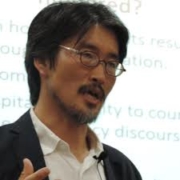Many universities around the world are focused on their efforts to internationalize. But what does that even mean? And what does that look in a single country, such as like Japan?
My guests today are Tom Brotherhood and Chris Hammond. Together with Yangson Kim, they have co-written a new article in the journal Higher Education that explores junior international faculty in Japanese Universities. Their actor-centered approach to the study of internationalization adds new insights about the phenomenon.
Tom Brotherhood is a doctoral researcher at the University of Oxford and a pre-doctoral fellow at the Research Institute for Higher Education at Hiroshima University. Chris Hammond is a doctoral student at the University of Oxford and an assistant professor in the College of Education, Psychology and Human Sciences at Aoyama Gakuin University in Tokyo, Japan.
Citation: Brotherhood, Tom & Hammond, Chris, interview with Will Brehm, FreshEd, 164, podcast audio, July 22, 2019. https://www.freshedpodcast.com/tombrotherhood-chrishammond/
Transcript, Translation, and Resources:
Will Brehm 1:25
Tom Brotherhood and Chris Hammond, welcome to FreshEd.
Tom Brotherhood 1:28
Thank you for having us.
Chris Hammond 1:29
Thanks for having us Will.
Will Brehm 1:30
So, what is internationalization of higher education? How would you explain that sort of, you know, in simple terms?
Tom Brotherhood 1:37
That’s a very good question and important and foundational for this research, I think. So, there’s many ways that researchers in higher education would define internationalization. And I think in the simplest possible terms, a quite neutral definition might be the proliferation of connections between universities and researchers and students internationally. And that’s quite a vivid way of understanding it, that kind of links nicely to the idea of globalization and the growth of these international linkages. But within higher education research itself, I think that Jane Knight provided a very influential definition that’s probably closest to the agreed upon definition for higher ed researchers. Permit me to read this very briefly, she defines it as the process of integrating an international, intercultural, or global dimension into the purpose, functions, or delivery of post-secondary education. Now, that’s a very broad and widely applicable definition of internationalization that I think has been used very broadly, particularly in the Anglosphere. And relative to that kind of neutral definition from before it presents a more normative view of what internationalization might look like. And it kind of puts forward the idea of reform and bringing our universities forward through this process. And that I think to us is really interesting, particularly in the Japanese case, because we can see that despite this effort to internationalize that hasn’t necessarily been that speed of reform that we might have come to expect from that. And that’s what led us to sort of focus on internationalization in our paper.
Will Brehm 3:10
And so, what is Japan doing to internationalize its universities?
Chris Hammond 3:16
Well, the government has been trying to implement a number of policies since the 1980s. They started with the 100,000 international students plan. That’s now been bumped up to 300,000 international students by 2020. In addition to bringing in students from abroad, there’s a lot of initiatives that tend to have the term ‘global’ involved in the name, Global 30, Global Japan. And now we have the “Super Global University Program”. So, in addition to bringing in more international students, another goal is to increase the number of Japanese students studying abroad from 60,000 in 2010, up to 120,000 by 2020. And another goal for some research intensive institutions is to try to get 10 Japanese universities into the top 100 World Rankings by 2024, which is an ambitious goal that I think a lot of other countries are trying to do at the same time. And then in addition to those, those are kind of the main goals but in some of the policy documents, we also identified that increasing the number of international faculty was also a goal. There weren’t any quantitative targets set for that one, though.
Will Brehm 4:32
So, more students from abroad, more Japanese students going abroad, more foreign faculty members, is there anything to do with curriculum? Or I mean, it just seems like we’re talking about student and faculty members here. But is there more to it in the Japanese case, you know, in this “super global” policy?
Chris Hammond 4:53
That’s a good question. There’s been a push to have more programs taught in the medium of English. So, not only English language programs, but EMI courses, that’s also connected to being able to draw students from abroad who might not have the Japanese language abilities that were required for university level study. In terms of Japanese students themselves, there’s a lot of goals like trying to improve TOEIC or TOEFL scores. Again, a lot of it is focused on English language, as somehow equated to the development of these global competencies. You hear the word global human resources, as another term that gets used quite frequently in a lot of policy documents and university websites. So, what creating global human resources actually means is up for debate. But that seems to be another important aspect of these initiatives.
Will Brehm 5:52
Yeah, it’s a strange term, what on earth is global human resources mean? I have no idea.
Chris Hammond 5:58
It’s very much a ‘human capital’ conception of higher education, I think. Although I’ve also found that the term is often adapted and sort of repurposed in many different ways by actors at universities, so that’s also quite interesting.
Will Brehm 6:14
So, it’s a malleable term that can sort of take on different meanings depending on which actor might need to utilize it for whatever reason. So, I mean, why on earth is Japan even thinking that internationalization is something that it should do in its university system?
Tom Brotherhood 6:30
Well, I think in the broadest possible sense, Japanese universities and the government too that is governing these universities are concerned about the decline that they’re witnessing relative to their neighbors, whether it’s the Chinese higher education or in global perspective. And the decline of these universities that we see in research productivity, but also in other ways, such as purely their struggles to find students are all related to some chronic social trends that are happening outside in the broader Japanese society. It’s easy to forget that Japan’s birth rate and youth population is particularly low and shrinking all the time. But its higher education sector is still one of the largest in the world at 700 universities. Now, inevitably, when you have this kind of mixture of conditions coming together, universities are concerned and are looking for ways to sort of bring themselves forward to reform and become more adaptive and perhaps more appropriate for the social situation in which they find themselves. So, internationalization is seen as one of the answers to these social challenges. First of all, it will allow them to create these competitive or elite institutions in global perspective by bringing in more foreign researchers to build this sort of collaborative links with foreign universities that are assumed to be particularly strong. It also allows universities that internationalize to be more visible domestically and seen as sort of a high-profile institution that has lots of international staff, lots of international students, and that’s seen as a measure of quality. And kind of final, a very fundamental point is that, as universities struggle to bring in enough students from the domestic body of young students, they’re looking abroad to fill the student places. Whether that’s looking to Southeast Asia, in particular, or China, to bring in students just to fill places and make sure those classrooms are full.
Will Brehm 8:22
So, internationalization in higher education in Japan, as Chris said, has been going on since the 1980s. And it does seem clear as to why they might want to do this. And so, you know, I mean, this is 40 years ago, basically, that this process has begun. And obviously, it has taken on different iterations and different forms over the years. But sort of looking back at it now, over these nearly 40 years, would you say this has been successful in any way? You know, where can we find success in Japanese universities because of internationalization?
Chris Hammond 9:02
Well, a lot of the metrics by which internationalization is measured are quantitative. And in terms of some of the goals -for example, the 300,000 international students by 2020- the government is saying, “we’re on track to achieve this”. Apparently, as of 2018, they had very close to 300,000 international students on the books. However, if you look closer, about as many as 160,000 of those students are actually attending vocational schools or Japanese language schools, which have come under scrutiny lately for being a front to provide visas, so people can work often in low-skilled manufacturing and service jobs. So, just looking at the numbers doesn’t really give you the whole picture. And based on the quantitative measures, arguably, Japanese internationalization is showing signs of success in terms of international faculty. A study by Professor Futao Huang showed that there’s been an increase from 1% of foreign faculty to about 4% in 2015. But again, a lot of scholars who’ve looked closer at what’s going on have found that even though in quantitative terms, there’s signs of success, in qualitative terms -and this in large part has to do with sort of the idea of integration that is part of Jane Knight’s definition of internationalization that we wanted to interrogate. This integration of international actors isn’t really happening very effectively. And that’s part of what we uncovered in our own studies.
Will Brehm 10:47
So, what does it actually even mean to integrate foreign faculty members? Like how, theoretically, you know, in an ideal situation, what would that even mean?
Tom Brotherhood 10:57
That’s a very important and critical point that we think is one of the weaknesses of the Jane Knight definition. Jane Knight herself says the integration of these international dimensions or global dimensions is important. And other influential definitions such as that by Hudzick also use that term “integrate”. But when you look at those text in more detail, there isn’t a definition or a vision necessarily for how this integration should take place. Now, this is something we looked at in more detail in our study. So, we looked at the migration studies literature, which has a great deal of discussion around what integration can and should look like. And in there, the idea of integration is most easily defined by the sense of mutual accommodation by both the mobile actor and the community or institution into which that actor is trying to integrate. Now, integration is easy to understand as a process by which they meet somewhere in the middle, the institution doesn’t change wholly to accept this person. And equally, the person who’s coming in, the mobile actor, doesn’t change wholly just to adapt to what already exists, they meet somewhere in the middle. And that’s what can lead to a process of reform. But that is not something that we found in this study in the Japanese context.
Will Brehm 12:11
So, an example of that would be what? So, a foreign faculty member comes to the university and to actually integrate would be able to rise up in the ranks of the university and maybe take on leadership roles, and, you know, would have to adapt to the cultural norms of the university but would also bring his or her own cultural background into that position of power to actually reform the university going forward. Would that be sort of the what integration might be able to look like?
Tom Brotherhood 12:44
Precisely, I think that’s a very good example of it. But I think even at a lower level, people can feel integrated if they have some way to have their voice heard within that institution, whether that’s, they just become an active and valued member of the faculty meetings that everyone will attend, or whether they’re able to vote in the presidential elections that take place at the university and things like that. But what we actually found was that even these small-scale examples in which they can have their voice heard on campus, are sometimes denied to these junior international faculty members.
Will Brehm 13:16
So, I mean, what’s the other extreme, then from integration, what the opposite would be what marginalization or being siloed? You’re there, but you, you basically can’t do much.
Chris Hammond 13:32
In our typology that we’ve developed in our paper, we did come up with three types of internationalization of mobile actors. And it’s not really a type of internationalization per se, it is, in fact, sort of the absence of any sort of incorporation at all. And we’ve termed that marginalization. And there’s an interesting example, in the case of Japan, that other scholars have also used. It’s the idea of Dejima, which was an island located in modern day Nagasaki that functioned as the only port for international trade during the closed country period of just over 200 years, during the Edo period in Japan. So Japanese people, citizens couldn’t cross the bridge, only a few select people, and vice versa, the Dutch traders were not allowed onto the mainland. And some scholars, including us, identified that a lot of the almost physical spaces, but sort of the ways in which international actors exist on Japanese university campuses, is sort of this Dejima, this marginalized space, for example, language centers, where foreign faculty might congregate and work together but they might never see their bosses, their superiors, they don’t get invited to attend faculty meetings, there’s a lot of precarity, short term, or limited term contracts that these faculty members are on, and they go through this cycle moving from one university to another trying to maintain their livelihood in Japan. It’s quite hard to really settle down and put down roots. And the idea of getting a tenured position, for example, it’s really difficult. I know, this is a global trend as well. But this idea of sort of being Dejimized or marginalized, really, kind of came out for us as being, I think, the major experience of most junior international faculty that we spoke to.
Will Brehm 15:44
And did many feel integrated in any way?
Chris Hammond 15:47
Yeah, not in our study. I don’t think we saw any examples of integration, as we defined it. We did see a few examples of assimilation. So, these tended to be faculty members, who had some relatively high level of Japanese language ability and they also tended to have a senior mentor, someone who kind of took them under their wing, introduced them to the right people, helped them become members of academic associations, and sort of gave them a roadmap for how to navigate a rather opaque Japanese academic system. But even those were, I think, few and far between out of the people that we spoke to
Will Brehm 16:38
So, it sounded like a very diverse sort of group of people that you spoke to that had these range of experiences mostly as assimilation and marginalization, not necessarily integration. But can you tell me a little bit more about these junior foreign faculty members that you spoke with. Did they perceive internationalization of higher education in Japan, as being successful? Was this seen as a positive, beneficial trend that they were participating in?
Tom Brotherhood 17:11
That’s a very good question and gets to the heart of this issue. I think the participants themselves did not necessarily have a clear idea of what internationalization should be or should look like. They were aware of the fact that they were a part of this process of internationalization that’s going on broadly in Japan. I mean, you can’t help but notice it if you’re in Japanese universities. But there wasn’t a clear idea of whether the internationalization was successful or not necessarily. Now, the way in which they are participants, when we push them on this and try to get there a little bit more detail, they inevitably sort of couch their understanding of internationalization in their own experience. Now, some of our participants were very happy to be working in Japan and were happy with the lot they had -perhaps they were in a good research position in a very good research center. And in this sense, they saw themselves as an international faculty member who was able to develop their career and was also able to contribute to their department. And in that sense, internationalization seemed like it was going really well. And this tended to be those that as Chris alluded to, before, were assimilating to these Japanese norms of higher education, and particularly research positions. On the other hand, a lot of participants, perhaps those who were in the marginalized group, as we saw it, they saw their personal frustrations and their inability to progress their career as an academic in Japan, as reflective of the wider issues with internationalization more broadly in the Japanese higher education system. So, in their experience, the barriers that they were having, and preventing them from whether it was getting promotion, or being able to have more of a voice in their department -the same barriers were stopping internationalization more broadly in the Japanese higher education system from moving forward. Certainly, they were not witnessing examples of the system changing in a meaningful way and reforming to be more international. And also, they weren’t pressed to say, if they saw this changing in the near future. I think we generally saw quite a pessimistic view on the idea of internationalization in its current form, being able to be a meaningful process of reform for Japanese universities.
Will Brehm 19:23
And how much of this actually has to do with language? I mean, did these junior faculty members that you spoke with, were they able to communicate in Japanese to actually speak to admin staff, or speak to other faculty members, to actually participate in this sort of day-to-day life in a university?
Tom Brotherhood 19:44
We spoke to around 23 people in total, and around half of them are just over half of them had a good level of Japanese language ability. And it’s certainly true that if you have that ability, it gives you more opportunities to integrate into your system, or to speak with the admin staff, as you say, and speak with your senior colleagues. And there’s certainly a great deal of opportunity that comes along with having that language ability. However, it doesn’t necessarily lead to an integrative style of internationalization. And the reason for that is, if you’re able to speak Japanese and your colleagues are able to communicate with you in Japanese, it seems like the trend there is for those senior colleagues to become mentors to you and bring you into a very Japanese form of academia. And you come to emulate the way in which Japanese colleagues are working. So, you may go to the same conferences, publish in the same journals, and particularly, you may be pressured to publish in the Japanese language, which while extremely valuable, if you’re trying to progress within the Japanese university system, inevitably siloes your research away from the international community. So, while Japanese language might be very effective in helping you to progress your career internally, it doesn’t necessarily tend towards this process of internationalization that may help the Japanese university system as a whole.
Will Brehm 21:05
That’s interesting. So, the very, perhaps, possibility of integration is, in a way maybe one step back of internationalization. And it is sort of like this balance, it’s not full on internationalization but there might be some integration by, like you said, going to the same conferences, running your labs in the same way as other Japanese professors might. So, would you say that sort of this strange balance that has to be sort of made?
Chris Hammond 21:39
I think that if you look at what’s going on in terms of international students, there’s a lot of, as I mentioned earlier, English medium of instruction, classes, and even full on degree programs that are proliferating across Japan now. And the idea, I think, behind those is not to only teach in English, but the teaching style also changes. There’s another buzzword we hear a lot in Japan is “active learning”, which is not a new concept, but it’s become quite popular here in Japan lately. But the idea of a class that’s taught in English isn’t only just the language, but there’s a new sort of discourse of the way the classes run, there’s going to be more discussions, there’s going to be more student-centered learning. So, the idea of the EMI program is one where there’s a significant change going on. And so, I think, looking at the integration of international faculty, like students, these might be measured quantitatively at the university level. “Oh, look, we now have 4% international faculty, so we’re done. We’ve accomplished our goal!” But really, if they’re kind of marginalized, not able to really participate in essentially their own experience as university faculty, if they’re required to assimilate and just sort of join the Japanese language class, as it were, by speaking Japanese, adopting all the typical norms, then integration of these new forms of internationalization, I think, aren’t going to happen as much. So, I think more support from administrative staff, from academics -again, this is kind of meeting in the middle. I think, the language issue is one that can be perhaps resolved by both sides, putting in their best effort to communicate, whether it be in Japanese or in English. I’ve worked at a few different universities. Now, some of the administrative documents and materials are provided in both languages, which is very helpful. Because reading Japanese is especially challenging, there’s a few thousand kanji, you have to learn just basic level kanji in order to read a document. So, there’s quite a high hurdle to get to that level. So, some universities have been quite supportive in that sense, others I’ve worked at have been much less so and getting a handful of emails all in Japanese, can be daunting and very time consuming when you have classes to plan for and things. So, I think this idea of kind of coming together in the middle is useful. Not just for students who are taking classes in English and Japanese, but also for faculty.
Will Brehm 24:32
Tom, did you want to jump in there and say anything to add on?
Tom Brotherhood 24:34
I think Chris covered it really well.
Will Brehm 24:37
Okay, perfect. So, I keep wondering about these struggles of junior international faculty members here in Japan. And I guess, sometimes I wonder, how much is it because they are international? And how much is it that they are actually just “junior”? You know, sometimes being in a junior position, in any institution, sort of results in some -you’re the lowest on the totem pole, in a sense. And so, you might just feel marginalized, even if you were in your home institution. So, were you able to sort of ascertain the sort of, how much of this is actually happening because of, you know, the international nature of these employees of these faculty members, versus how much is it because their junior status?
Tom Brotherhood 25:25
That’s not something we were able to isolate clearly or numerically any sense. And actually, that’s kind of part of the research agenda going forward that we need to look into that in more detail. In this study, we did only look at the junior international faculty members, but Professor Huang’s study that we were kind of inspired by, they looked at some professor level, international faculty members in Japan who’d been here for a long time that had been very successful by many accounts. And I think it’s, in their cases, what you often found was that they had trained in Japan, from their doctoral level, and had very high levels of Japanese ability, were often married to Japanese nationals. And in that sense, they are the example of very successful assimilation to Japanese academic norms. And that, in many ways, has been very successful for Japanese universities. There is a large number of successful people, particularly from East Asia, who have become successful and very productive researchers in Japanese higher education. What we were looking at more specifically, and by focusing on the junior faculty members, we’re looking at more specifically that agents of change idea. These people are seen in the international literature -and this has been influential for Japanese policymakers- as being these young, dynamic people, who can come in and in building their careers, will also contribute to this process of reform of the universities themselves. And if that’s the goal of internationalization in Japan, if by bringing in young people with this dynamism and these new ideas is the goal, by changing the universities themselves, it’s important to look at those junior people and see that even at the junior level, they have some scope to have a voice in their universities. And that we didn’t find. So, it’s certainly there is an interaction there of being international and being junior, but I don’t think it’s possible for us from this study to identify whether it’s “because” they were international, “because” they were junior that they were marginalized or not able to necessarily integrate into the mainstream of their universities. But in the context of Japan, it’s the fact that they are junior that is so important that that’s why we needed to focus on this. And if their junior status is something that’s coveted by the policymakers that are putting all this funding forward to bring them into the universities then that’s what we wanted it to focus on in the study itself.
Chris Hammond 27:50
Just one quick, sort of practical example to add on to that. Just before we started this call, I was called into a meeting -the faculty meetings actually take place right across the hall from my office here. And again, just like any other university, I’ve worked at here, I don’t get invited to those. But I did get asked to come in to take part in a brief ethics meeting for research ethics and there was maybe 70 or 80 academics and administrative staff in the room. Once the research ethics meeting was over. I and about three other Jokyou, assistant professors, again, we’re contract-based professors. I was the only non-Japanese of the four or so people. We all left the room, so the faculty meetings could start. So, just to give you a very sort of concrete example, it isn’t only the international stuff, it is very much, I think, those who are considered precarious workers or contract non-tenured faculty. In addition to people like me, who have essentially a five-year contract at the university where I’m at now, there’s a lot of part-time teachers, lectures, even professors that come and go at all of these universities here in Tokyo. So not only is term limited job, those which are almost coveted. I mean, tenure is really sort of this dream that people including young Japanese junior faculty members are striving for. A lot of people are kind of stuck in this cycle of part-time work where they travel from university to university. I know this isn’t only happening in Japan, it’s connected to sort of the neoliberalization.
Will Brehm 29:37
Yeah, it seems like this is an intersection to neoliberalization exactly.
Chris Hammond 29:41
Yeah. So, I didn’t even want to consider working in the US. -it’s super competitive. And I’ve heard of these young PhDs getting in their car and driving from university to university, having to meet students in the parking lot to talk about class. Japan by comparison is actually quite nice but I can’t speak about the states. But anyway, that’s just an example that I had from today.
Will Brehm 30:09
Yeah. I mean, it is interesting, right? Because I do think that the internationalization of higher education and sort of the neoliberalization of higher education, there’s intersections that have to be explored as well. And I guess, just sort of end, I want to reflect back on the sort of the beginning where, Tom, you mentioned Jane Knight sort of normative framework for internationalization of higher education. And it might not be agreed upon by everyone, but it’s sort of the standard working definition at this time. And after our conversation, I’m curious to hear your opinion, is there, in a sense, a different normative agenda in a place like Japan when it comes to internationalization, then that which is implied in, say, Jane Knights definition?
Tom Brotherhood 31:01
That’s a fantastic question, I think, and one that we are trying to engage with along with a number of other researchers. Now, people have suggested that the Jane Knight definition is in itself, kind of couched in the experiences of American, the British, and European universities who perhaps just by having a head start and being internationalized by being so attractive to international researchers for a long time. By the time Jane Knight came along and wrote this definition, an understanding of what internationalization should look like, it was kind of already embodied by universities across the Anglosphere in Europe. Now, that is not the case in Japan, and researchers such as Rui Yang have pointed that out that in countries such as Japan, and China, the sort of embodied culturally specific practices of whether that’s bringing in international researchers to focus on high level of research, and to teach in the English language. This implies the imposition of a Western idea of higher education. And when you’re applying this to Japan, and China, it’s the imposition of Western models of higher education onto these non-Western societies who may have very different ways of organizing their universities. I think a striking example, as we pointed out earlier in this discussion, is the idea of global league tables or global rankings. And these inherently impose a standardized template of the Anglo-American research intensive university as the basis of judgment. And this will inherently norm out these other models that may have existed in Japan or China. Yet, without question, these global rankings are heavily influential in Japan’s internationalization agenda. So, I think, as you allude to, Japan is a great example of the way in which internationalization and the neoliberalization of the university are entangled in a sense. Japan is heavily neoliberal in many ways. Its national universities were incorporated in 2004. And global rankings competition and being globally competitive is at the forefront of a number of policy reforms, including internationalization.
Will Brehm 33:15
Well, Tom brotherhood and Chris Hammond, thank you so much for joining FreshEd and best of luck as you continue this research agenda on internationalization of higher education, particularly in Japan.
Tom Brotherhood 33:25
Brilliant, thank you very much.
Chris Hammond 33:27
Thanks very much Will.
Higher Education Internationalization in Japan










